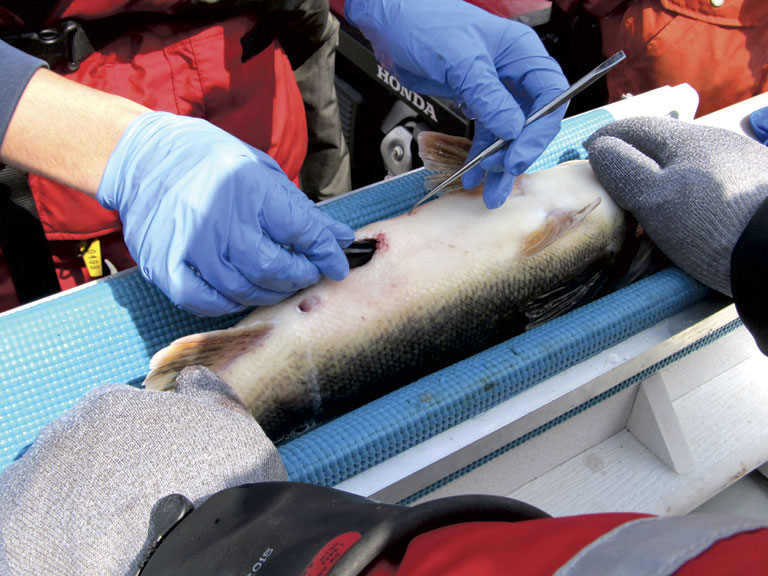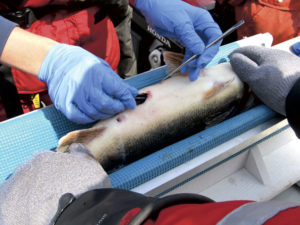County News
Fish tracking

Glenora fisheries conducting walleye research
The Glenora Fisheries Station (GFS), located next to the Glenora Ferry east of Picton, is now two years into a study on the habits and trends of walleye in the Bay of Quinte region. The study is partway into a multiyear analysis of where walleye spawn, their trends and how far they travel. Being that this area is popular with local anglers, the study also notes where the fish like to congregate, which not surprisingly, lines up to many popular fishing holes in the Bay Of Quinte region.
There is a lot of history to the GFS unit, but surprisingly not a lot of people in the County seem to know about its existence and its importance to the waters of the area. The facility is unique across the Great Lakes, and is the only provincial station on the northern shores of Lake Ontario. Their work spans the entire lake and they work closely with their American counterparts.
Erin Brown took over the walleye tagging project a year ago from a member of the team who was retiring, and for her, the chance to work on Lake Ontario was an opportunity she’s been waiting for. Brown has a background in fisheries sciences and has experience working with inland lakes, most recently as an assessment biologist on Lake Simcoe. Brown has worked with walleye in the past, specifically in the Kawartha Lakes area, but is learning a lot of new information about the walleye in this region through the historical information housed at the station.
GFS has a number of assessment programs to monitor the status of the Bay of Quinte and Eastern Ontario stock of walleye, and overall the monitoring program indicates that the status of our stocks is good. The fisheries station manages the population in the Bay of Quinte and Eastern Ontario as one stock. In the ’90s, the area saw population decline in walleye, but the numbers have since stabilized over the years, and if you talk to any local anglers, they’ll tell you that the fishing in this area is top notch.

An electronic tag is surgically inserted into a walleye for the study.
For the walleye study, Brown will also help monitor its population through regular recreation angling surveys as well through fish community netting surveys. Through these surveys they can collect information on harvests (how many fish were taken from the population by anglers), abundance, how quickly they grow and how healthy they look. But Brown and the team at GFS knew that finding out where they travel is also vital information.
We recognized there was a better need to understand and describe the movement of the walleye at a finer scale than currently exists, so we decided on acoustic telemetry as the best tool to extract that information,” says Brown.
For the study, the walleye are surgically implanted with small electronic transmitters and then released back into the water. These transmitters have a unique series of pings that send out specific ID codes unique to each fish. These pings are broadcast by the transmitter in the water and picked up by underwater receivers that the GFS have strategically placed throughout Lake Ontario and the Bay of Quinte. When a walleye swims past that receiver, that ID code is picked up on the receiver and a date and time stamp is recorded. Using that data Brown and the team can infer movement through those receivers placed around the lake. The receivers are considered mini-computers that sit untended in the water for up to six months to a year before having to be physically retrieved to extract the information.
For only being halfway through the study, Brown has noticed some interesting trends developing already. The transmitters in the walleye have a five-year lifespan, so Brown will be tracking these walleye for another few years, but has some early insights.
“Something surprising for us to learn is that the walleye that spawned in the Bay of Quinte moved out of the bay very quickly after spawning, and by quickly mean one to two weeks after. We also noticed some hot spots where walleye like to congregate that aren’t ones that the local anglers seem to be aware of,” says Brown.
If a local fisherman catches a walleye that has been fitted with a transmitter, there will also be an external tag on the dorsal side which also has a unique ID code and the GFS’s telephone number on it. The angler has a couple of moral options at this point. The GFS would the angler to release the fish because of the vital information it is providing to the study over the multiple years. If they do decide to keep the fish, they can still return the internal tag, which has a five-year lifespan and could be re-deployed in another fish. If someone is looking to return an internal tag, they just ask that you not keep the fish in freezer prior to bringing it to the station because the tag will be unusable after being frozen.
Walleye fishing is very popular among anglers in this area and the GFS want to make sure that they can sustain the high quality of fishery that exists now.
“Walleye have very specific movement patterns, so we now know were the fish go to spawn, where they go to feed and we know that they are somewhat restricted by temperature. We want to use this information to better determine the seasonal distribution of these walleye as well understand their movement patterns, which will result in a better managing of the fishery” says Brown.
The Glenora Fisheries Station was originally opened in 1922 after the property was purchased by the government of Ontario. It existed as a fishery for 32 years before operations were discontinued in 1954. The facility was dedicated to Lake Ontario fisheries research in 1957 and then re-opened as a fishery station again in 1989. The ongoing studies at GFS have allowed them to accumulate an archive of fisheries information dating back 50 years, a collection considered unrivalled in freshwater fisheries science.

Comments (0)